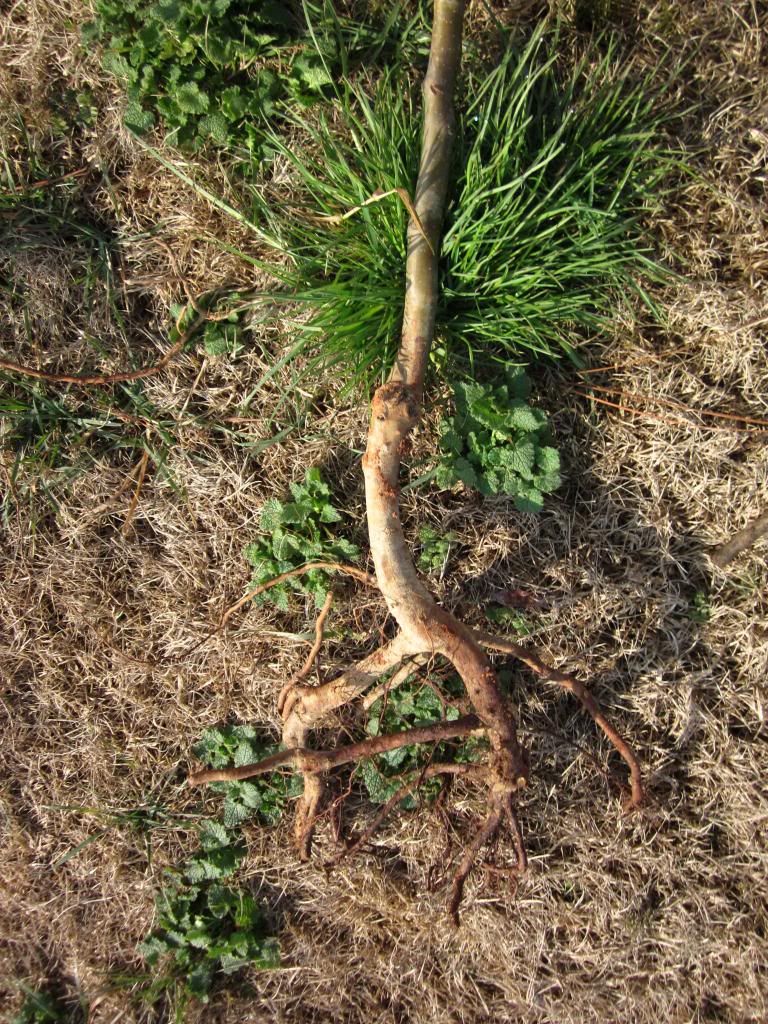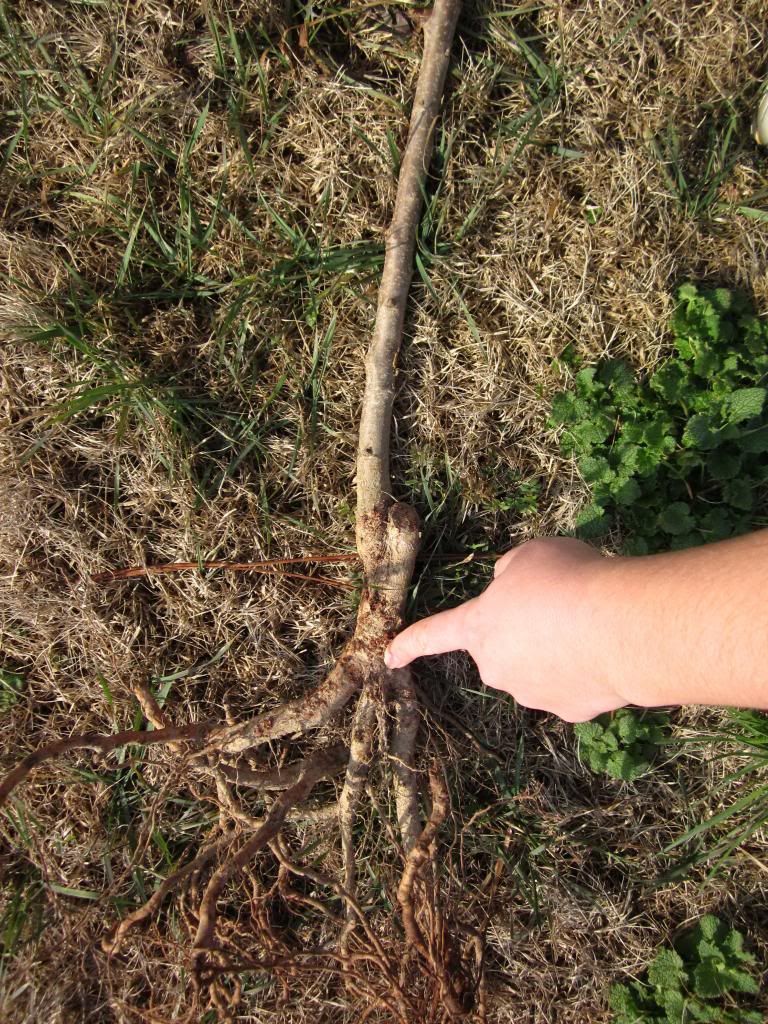I apologize for falling behind on blogging. School this semester has not left a lot of free time for writing, but I do want to continue with regular posts. So, in the spirit of brevity, please enjoy the following quick and dirty tips for planting trees. Stay tuned for the quick and dirty tips for pruning.
Timing is Everything
Cool winter months is a great time to plant dormant trees and shrubs. Without the burden of green foliage that requires a constant flow of water, woody specimens are able to develop a healthy root system. The earlier in the winter that you plant your trees, the more time their roots have to develop, and the better prepared the trees are to withstand summer heat. In Knoxville, March is about the latest that I would recommend planting trees and shrubs.
Container or Bare-Root?
Many homeowners buy trees and shrubs grown in containers from a nursery or box store. While I am all for supporting your local nursery, I prefer to plant "bare root" woody specimens. Bare root plants are exactly what they sound like -- there is no soil around their roots. In my experience, bare root trees and shrubs are less expensive, establish faster and perform better than container grown plants. Bare root specimens can be ordered through the internet or catalogue from a reputable source. Ball and burlap is another option as well.
Eliminate the Competition
Although most weeds in and of themselves may not be a threat to successful growth of trees and shrubs, their presence near the trunk is undesirable for a couple reasons. Aesthetically, you may not want weeds cluttering up the "drip zone," or area beneath the foliage of your tree. If the tree is to be planted in an area that is mowed regularly -- like the front yard -- if there are weeds and grass growing near the trunk you may risk having your tree damaged by a weed eater or lawn mower. For these reasons, it is a good idea to use your shovel to remove existing weeds and grass from the area around your tree prior to planting.
Dig Baby, Dig
If your tree is a container tree, make sure your hole is at least bigger than the plant's container. Some people suggest digging a hole that is twice as wide. I haven't noticed much of a short or long term difference between the growth of trees that were planted in sufficient size and larger holes. If you are planting a bare root tree or shrub, make sure the hole is large enough to sufficiently hold all the roots.
To Amend or Not to Amend
Some people amend the soil in the hole with potting soil, good topsoil, sand, compost, or fertilizer. I like to think of it this way -- in a year, your tree's roots are going to expand far beyond that zone. Why put off the inevitable? In some cases, amending the soil can actually hurt the tree's development. For example, if a heavy clay soil is amended for a tree, the slow draining clay can create a basin that holds water around the tree's roots and causes them to rot. However, if you are growing a tree or shrub that has a specific soil pH (acidity or alkalinity) requirement, the soil will need to be amended with sulfur to lower pH and make more acidic or lime to raise pH and make more alkaline in order for the tree to grow properly.
Look for the Root-Shoot Junction
There have been times when I've planted a tree and a year later it dies inexplicably. My sleuthing did not turn up any fatal pest or disease problems. The cause of the tree death was actually being planted too low or too high. Now when I plant trees, I keep my eyes peeled for something called the "root / shoot junction." Look on the trunk of your tree for the spot where the roots become the roots and the shoot becomes the shoot. When you plant your tree, make sure the roots are below ground and the trunk is above ground. Most of the time, the soil line of container grown trees is already at the root / shoot junction, but double check to be sure.
Add Mulch
Mulch is important for weed suppression, protecting the trees from lawn mower or weed eater damage, and just plain old looks pretty. For new beds, add about 3 inches of mulch under the drip zone of the tree. After mulching, be sure to pull the mulch away from the trunk of the tree. Be sure to avoid the "mulch volcano" look -- that is not attractive and it is unhealthy for your tree.
Thanks for reading and stay tuned for the quick and dirty tips for pruning, hopefully coming up soon!
If you have any questions, ideas, or comments, please don't hesitate to leave a comment or send me an email.
To see more of my tree maintenance pictures, check out my photobucket story.
Do you prefer container trees or bare-root? What tips and tricks have made your trees and shrubs grow successfully?
Timing is Everything
Cool winter months is a great time to plant dormant trees and shrubs. Without the burden of green foliage that requires a constant flow of water, woody specimens are able to develop a healthy root system. The earlier in the winter that you plant your trees, the more time their roots have to develop, and the better prepared the trees are to withstand summer heat. In Knoxville, March is about the latest that I would recommend planting trees and shrubs.
 |
| A "bare root" tree is exactly what it sounds like -- there is not soil around the roots. |
Many homeowners buy trees and shrubs grown in containers from a nursery or box store. While I am all for supporting your local nursery, I prefer to plant "bare root" woody specimens. Bare root plants are exactly what they sound like -- there is no soil around their roots. In my experience, bare root trees and shrubs are less expensive, establish faster and perform better than container grown plants. Bare root specimens can be ordered through the internet or catalogue from a reputable source. Ball and burlap is another option as well.
Eliminate the Competition
Although most weeds in and of themselves may not be a threat to successful growth of trees and shrubs, their presence near the trunk is undesirable for a couple reasons. Aesthetically, you may not want weeds cluttering up the "drip zone," or area beneath the foliage of your tree. If the tree is to be planted in an area that is mowed regularly -- like the front yard -- if there are weeds and grass growing near the trunk you may risk having your tree damaged by a weed eater or lawn mower. For these reasons, it is a good idea to use your shovel to remove existing weeds and grass from the area around your tree prior to planting.
 |
| Make sure your hole is at least big enough to hold all of the plant's roots. |
If your tree is a container tree, make sure your hole is at least bigger than the plant's container. Some people suggest digging a hole that is twice as wide. I haven't noticed much of a short or long term difference between the growth of trees that were planted in sufficient size and larger holes. If you are planting a bare root tree or shrub, make sure the hole is large enough to sufficiently hold all the roots.
To Amend or Not to Amend
Some people amend the soil in the hole with potting soil, good topsoil, sand, compost, or fertilizer. I like to think of it this way -- in a year, your tree's roots are going to expand far beyond that zone. Why put off the inevitable? In some cases, amending the soil can actually hurt the tree's development. For example, if a heavy clay soil is amended for a tree, the slow draining clay can create a basin that holds water around the tree's roots and causes them to rot. However, if you are growing a tree or shrub that has a specific soil pH (acidity or alkalinity) requirement, the soil will need to be amended with sulfur to lower pH and make more acidic or lime to raise pH and make more alkaline in order for the tree to grow properly.
 |
| Look for the "root / shoot" junction before planting your tree. |
There have been times when I've planted a tree and a year later it dies inexplicably. My sleuthing did not turn up any fatal pest or disease problems. The cause of the tree death was actually being planted too low or too high. Now when I plant trees, I keep my eyes peeled for something called the "root / shoot junction." Look on the trunk of your tree for the spot where the roots become the roots and the shoot becomes the shoot. When you plant your tree, make sure the roots are below ground and the trunk is above ground. Most of the time, the soil line of container grown trees is already at the root / shoot junction, but double check to be sure.
Add Mulch
Mulch is important for weed suppression, protecting the trees from lawn mower or weed eater damage, and just plain old looks pretty. For new beds, add about 3 inches of mulch under the drip zone of the tree. After mulching, be sure to pull the mulch away from the trunk of the tree. Be sure to avoid the "mulch volcano" look -- that is not attractive and it is unhealthy for your tree.
Thanks for reading and stay tuned for the quick and dirty tips for pruning, hopefully coming up soon!
If you have any questions, ideas, or comments, please don't hesitate to leave a comment or send me an email.
To see more of my tree maintenance pictures, check out my photobucket story.
Do you prefer container trees or bare-root? What tips and tricks have made your trees and shrubs grow successfully?
 |
| The Knoxville Botanical Garden and Arboretum's "Every Child Outdoors" Fruit Grove |
